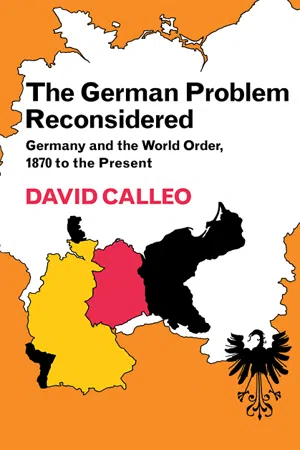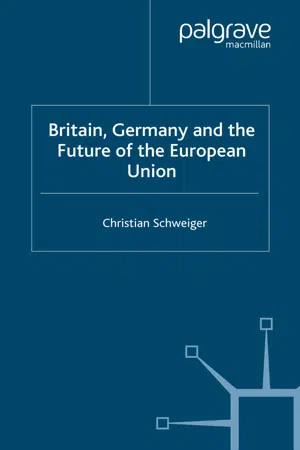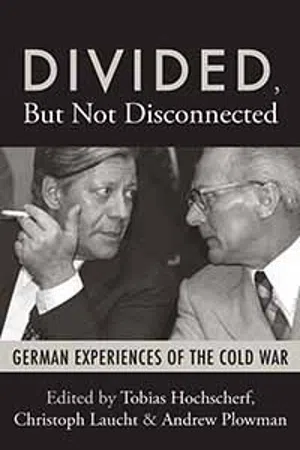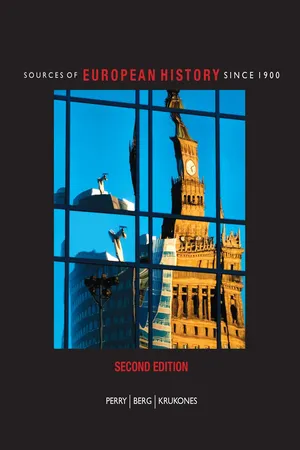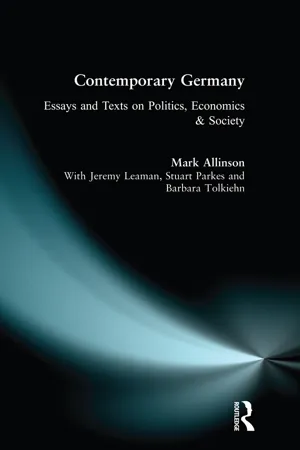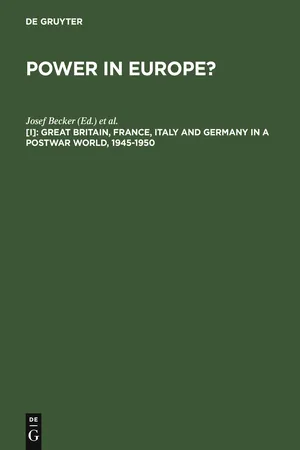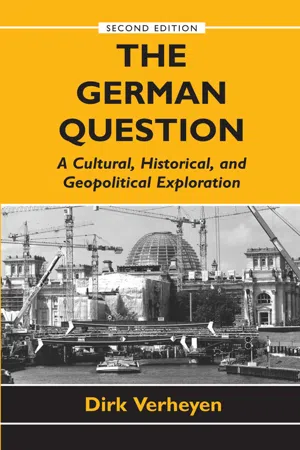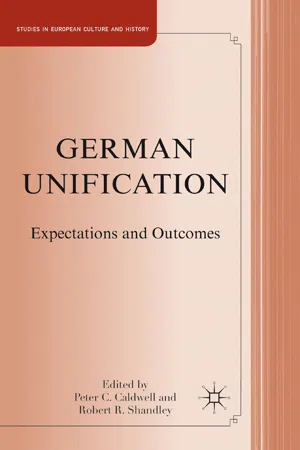History
West Germany
West Germany refers to the western portion of Germany that existed from 1949 to 1990. It was established after World War II and was a democratic state, aligned with the Western bloc during the Cold War. West Germany experienced rapid economic growth and became a key player in European politics and economics before reunification with East Germany in 1990.
Written by Perlego with AI-assistance
Related key terms
1 of 5
11 Key excerpts on "West Germany"
- eBook - PDF
A History of Germany 1918 - 2014
The Divided Nation
- Mary Fulbrook(Author)
- 2014(Publication Date)
- Wiley-Blackwell(Publisher)
In 1949 many West Germans saw a potential new role in a new Europe. They could set their sights forward, and try to forget – or repress – the traumas of the recent past. In the East things did not appear nearly so rosy. Economic conditions were by no means as favourable as in the West; and political repression was increas- ingly evident, particularly after 1948. Yet even in the East it had been made clear to former ‘small Nazis’ that they could find a role for themselves in the new state if they were prepared to participate and help in the new tasks of building socialism. In the East as well as in the West many Germans wished simply to forget the past, and lived day-to-day, seeking to make the best of current circumstances and harbouring their respective hopes for the future. Yet the foundations which had been laid by 1949 set the pattern for paths followed in the future: diverging paths which shattered the hopes of many for another kind of new Germany after the defeat of Hitler’s Reich. A History of Germany 1918–2014: The Divided Nation, Fourth Edition. Mary Fulbrook. © 2015 John Wiley & Sons, Ltd. Published 2015 by John Wiley & Sons, Ltd. Crystallization and Consolidation, 1949–1961 The period from the foundation of two separate states in 1949 to the erection of the Berlin Wall in 1961 is one in which the division of Germany was confirmed, and in which the peculiar characters of the two new states were consolidated. While in 1949 much still appeared open, by the begin- ning of the 1960s patterns had been laid which were to shape the next quarter of a century of German history. Before considering the historical development of East and West Germany in this crucial decade, we must briefly consider certain features of their constitutions and political systems. - eBook - ePub
- M. Donald Hancock, Henry Krisch(Authors)
- 2008(Publication Date)
- CQ Press(Publisher)
This “cold civil war” on German territory ended with the collapse of the East German state in 1989, the acquiescence of the Soviet Union to German unification within the Western alliance a year later, and the unification of Germany as the Federal Republic of Germany. This proved to be a struggle between two uneven partners. The victorious western Federal Republic was larger, more populous, better endowed with natural resources, and linked to the economically and militarily more powerful ally. Thus the resolution of Germany’s problems in the Cold War historical era has led to a united Germany that must cope with a difficult dual heritage (Nazi and communist), as well as with the task of integrating a poorer, smaller, defeated region into the modern German polity. 1 Competing Regimes As shown in chapter 2, the erosion of four-power Allied control led to the emergence of competing regimes. The Western Allies established interzonal economic coordination (1946–1948) and a Parliamentary Council (Parlamentarischer Rat) to prepare the formation of a government in the Western zones. The Soviet authorities, from 1947 on, established “administrations,” which in 1949–1950 became a Soviet Zone government. 2 In the fall of 1946 the United States and Britain negotiated a series of agreements to establish joint agencies governing finance, agriculture, transportation, and communication. These arrangements were made in close consultation with German administrative officials and were formalized in a two-power agreement signed in December that established “Bizonia.” The formation of Bizonia coincided with the revival of German political life throughout the divided nation. Statewide elections were held in June 1946 in the American zone to choose delegates to draft new state constitutions. French, British, and Soviet officials conducted local elections in September, and statewide elections followed in the Soviet zone in October - David Calleo(Author)
- 1980(Publication Date)
- Cambridge University Press(Publisher)
And the Germans themselves, at least in the West, soon grew attached to the comforts of integration within a larger and relatively stable systemic order. In short, a united neutralist Germany, with all its uncertainties, had little practical appeal either for Ger- many's conquerors or among the Germans themselves. THE GERMAN PROBLEM AFTER 1945 163 With postwar Germany firmly divided, is the traditional German Problem therefore solved? The question seems most relevant for the Federal Republic, the major fragment of the old Germany and still a major power in the world. In some respects, despite its heavy political liabilities, Germany under the Federal Republic has managed to find a more comfortable place in the international order than under either imperial or Nazi regimes. Above all, the Federal Republic has succeeded in the economic sphere. Initially, West Germany's economy was directly controlled by the Allies. One current in early American thinking was embodied in the so-called Morgen- thau Plan. Outright revenge combined with fears of over- production to envisage dismantling German industry alto- gether. But more temperate views prevailed and German recovery was deemed essential, a determination strength- ened as Western European recovery stalled and the Cold War grew intense. West Germany was given full place within the Marshall Plan. Moreover, the Allied currency reform of 1948, sustained by a policy of tight money and balanced budgets, endowed Germany with a stable and undervalued currency, a firm foundation for export pro- motion and domestic investment. Political reconstruction proceeded along with economic. In 1949, the Allies for- mally established the Federal Republic and gradually lifted the remaining economic disabilities. The Korean War prompted the United States to promote and finance a major rearmament of the West, including ultimately the Federal Republic. Substantial flows of direct American aid fueled a major Western boom.- C. Schweiger(Author)
- 2006(Publication Date)
- Palgrave Macmillan(Publisher)
As Werner Link points out, under normal circumstances, the European policy interests of a country emerges in a process of competition with the national interest and does not simply exist naturally (Link, 1999, p. 562). The discussion about a possible redefinition of the Federal Republic’s foreign policy approach had therefore already begun before 1989/90. This was mainly due to the fact that West Germany’s economic weight increased to an extent which made the traditional policy of understatement appear increasingly dishonest. The legacy the West German Federal Republic bequeathed to the unified Germany was therefore one which had suited its semi-sovereign status before 1990. The policy of European multilateralism and the civilian power attitude rebuilt West Germany’s post-war reputation on the 56 Britain, Germany and the Future of the European Union international stage and allowed the country to pursue its economic interests without raising cause for concern among its neighbours. The combination of Westbindung and Ostpolitik provided the right mixture for West German economic prosperity as it combined the important export market of the EC with new markets in the East. The Bonn repub- lic consequently emerged as an economic giant and a political dwarf. If one takes into account the limit for political manoeuvre imposed as a result of the occupational rights of the Western Allies, West Germany had nevertheless managed to gain a substantial political role in post-war Europe. Internal and external changes after reunification The fall of the Iron Curtain in 1989/1990, which had divided Europe for over than forty years, brought an end to the abnormal post-war situa- tion in which the German nation had to live in two separate states.- eBook - PDF
Divided, But Not Disconnected
German Experiences of the Cold War
- Tobias Hochscherf, Christoph Laucht, Andrew Plowman, Tobias Hochscherf, Christoph Laucht, Andrew Plowman(Authors)
- 2010(Publication Date)
- Berghahn Books(Publisher)
As a result the physical – and not only the virtual, media-based – presence of the West in the East was perpetuated and became a consti-tutive feature of GDR reality. On comparison, it is evident that this Cold War peculiarity – an East-West border right in the middle of the country – was complemented and contrasted by a fundamentally different experience on Germany’s Western rim. There, a reverse process set in, leading as the Cold War continued to the gradual dissolution of restrictive border regimes in the context of (West) European integration. In regions like Baden-Württem-berg or the Saarland, borders acquired a historically new meaning. In the context of NATO and the Western security system, the western borders themselves lost their relevance as military objects. They no longer con-stituted zones of potential danger for the security of the polity. Further-more, West Germany’s integration into ‘the West’ and the West European Economic Community in particular was accompanied by conscious ef-forts to overcome the mutual suspicions of former ‘arch-enemies’. This secular change took place not just on the level of diplomatic and eco-nomic relations and of military alliances: it became practically relevant for millions of people throughout society. As a result of the intensifica-tion of travel with the increase of automobile traffic, borders between Germany and France, Belgium and so on came to be experienced ever more in terms of the opportunity for transition and regular mutual con-tact in an essentially positive sense. In everyday terms this shift took the form of shopping trips and weekend tourism for the residents near the border. It became relevant for wider parts of the West German popula-tion once travelling abroad by car for the annual holiday became a mass phenomenon. 14 In itself this change in the meaning of borders does not appear sensa-tional, as the same process took place also at the other borders in West-ern Europe. - eBook - PDF
Sources of European History
Since 1900
- Marvin Perry, Matthew Berg, James Krukones, , Marvin Perry, Matthew Berg, James Krukones(Authors)
- 2010(Publication Date)
- Cengage Learning EMEA(Publisher)
During the mid and late 1950s, the West German econ-omy took advantage of its newly established stability and began to grow steadily as a manufacturing and consumer-based economy with a strong agricultural sec-tor, soon becoming the most dynamic economy in Western Europe. As of the early 1960s, the Federal Republic’s “economic miracle,” or Wirtschaftswunder , became an object of admiration for its neighbors. West German economic success, like that of Japan, helped to ensure social stability; this, in turn, worked against any potential embrace of communism or a return to violent, intolerant nationalism. By the time Ludwig Erhard extolled the virtues of the Federal Republic’s social market economy in 1960 (see page 364 in this volume), West Germany had undergone a transformation that no one would have dared imagine possible in the spring of 1945. Stephen Spender’s observations of German circumstances immediately after the war’s conclusion and Theodore White’s overview of conditions between 1945–47 stand in marked contrast to what White encountered by the time Marshall Plan aid and initial Western European economic integration helped infuse life into the West German economy in 1952. The following selection reveals the astonishment White felt upon each of his periodic visits during his extended reportage on developments across postwar Europe. No traveler making the seasonal circuit of Europe’s political centers has failed to describe how swiftly the face of Germany has changed since the ending of the Winter Years. Once set on its upward course in 1949, Germany changed from month to month. People in the streets filled out visibly. Their clothes changed from rumpled rags to decent garments, to neat business suits, Section 3 The New West Germany 297 Copyright 2009 Cengage Learning, Inc. All Rights Reserved. May not be copied, scanned, or duplicated, in whole or in part. 298 Chapter 6 Western Europe: The Dawn of a New Era to silk stockings. - eBook - ePub
Contemporary Germany
Essays and Texts on Politics, Economics & Society
- Mark Allinson, Jeremy Leaman, Stuart Parkes, Barbara Tolkiehn(Authors)
- 2014(Publication Date)
- Routledge(Publisher)
Nationale Volksarmee ) came into being in 1956.Germany’s more permanent division was further emphasised in 1955 by Adenauer’s visit to Moscow. In formally recognising the Federal Republic as well as the GDR, the Soviet Union seemed to acknowledge the status quo. For his part, Adenauer had travelled east to establish diplomatic relations with Moscow, as one of the four powers on which German unification would ultimately depend, but also to secure the release of the many German prisoners of war still held in camps in the USSR some ten years after the end of the war. The emotional scenes of tens of thousands of German troops returning to their homes and families ensured that the visit was a great success for Adenauer. However, the diplomatic recognition of the Soviet Union had created a problem. How could the Federal Republic maintain relations with a state which also recognised the GDR, a state which Adenauer’s government regarded as illegitimate? While diplomatic relations with one of the four allies could be presented as an exceptional necessity, to avoid the diplomatic problem of maintaining West German embassies around the world in capitals which also hosted GDR missions, Adenauer’s foreign policy advisor, Hallstein, declared that the Federal Republic would not maintain diplomatic relations with any state which also recognised the GDR. This ‘Hallstein doctrine’, which remained at the heart of West German foreign policy until the late 1960s, entrenched the division of Germany and Europe still further: it isolated the GDR diplomatically, as most countries preferred to maintain links with the stronger FRG, but in practice also denied the Federal Republic official influence among the GDR’s eastern European allies. - Josef Becker, Franz Knipping, Josef Becker, Franz Knipping(Authors)
- 2011(Publication Date)
- De Gruyter(Publisher)
1, p.878, Note 1. ' Details in: Overesch, 'Der historisch-politische Stellenwert', loc. cit., pp. 77f. Senior West German Politicians 121 other political forces, before it had finished work on the draft of a constitution of the German Democratic Republic. 10 At the time, the Bremen setback was not yet seen as particularly discourag-ing. If we are not completely mistaken, wrote Jakob Kaiser on January 1, 1947, in the newspaper of the Eastern Zone CDU, Neue Zeit, this is the beginn-ing of a year that will give a new unity to Germany; to which he immediately added the principle upon which political progress in Germany should be based: Whoever desires the recovery of Germany can only start from the fact that Germany is situated between East and West; the consequence of this fateful but also challenging situation is not the alternative between either a Western or an Eastern Bloc, but the synthesis of both understanding and reconciliation among the peoples and recovery by one's own spirits. This theory of Germany as a bridge between East and West had also been favoured by Bremen's Senator Harmssen at the Interzonal Conference for Economic Matters. 11 From the political point of view, and in the light of the experiences of German history in the Bismarck era and during the 18th and 19th centuries, this seemed, in the international situation after 1945, to many people not completely wrong. Kaiser, who had his roots in the Christian trade union movement, thought it worth taking into consideration in domestic politics, too, if a form of German Socialism could be found that does not mean a mechanical fixation of man, but opens spaces for the free development of his personality. 12 This was also the basic idea of, for example, the Buchenwalder Manifest for peace, freedom, socialism, published on April 11, 1945, by Hermann Brill and others in the Buchenwald concentration camp and intended to announce a new orientation of German politics.- eBook - PDF
Religion and the Cold War
A Global Perspective
- Philip E. Muehlenbeck(Author)
- 2012(Publication Date)
- Vanderbilt University Press(Publisher)
18 CHAPTER 2 The Western Allies, German Churches, and the Emerging Cold War in Germany, 1948–1952 JonDavid K. Wyneken A t the end of the Second World War in Europe, few could have predicted just how quickly quadripartite cooperation would deteriorate. The prior-ities of the superpowers shifted rapidly away from punishing Nazis and com-ing to terms with the catastrophe of the war and moved toward fighting a new Cold War, which divided Europe and much of the world into opposing ideo-logical, political, and military camps. The defeated nation of Germany proved to be the literal and figurative divider between these opposing blocs. Shat-tered, occupied, and without sovereignty, Germans understandably believed that their fate in this burgeoning global conflict was not in their own hands and therefore cultivated authorities who could lobby the quadripartite powers on their behalf. The Allies, meanwhile, also sought out individuals and organi-zations that might support their objectives for the postwar occupation. Devel-opments in the occupation of Germany influenced the broader international relations between the quadripartite Allied powers, while those relations sym-biotically helped shape the occupation and the processes that characterized the developing Cold War. These factors all proved to be quite volatile, as a largely ambivalent and occasionally hostile German population caused difficulties for the Western Allies on a number of fronts, making inter-Allied cooperation even more difficult and feeding the tensions that steadily drove the wartime alliance apart and into a confrontational framework that would span several more generations. In the three Western occupation zones, Allied authorities to varying Western Allies, German Churches, and the Emerging Cold War in Germany | 19 degrees sought the support of German Catholic and Protestant leaders to help ensure wider German acceptance of occupation reforms. - eBook - ePub
- Dirk Verheyen(Author)
- 2018(Publication Date)
- Routledge(Publisher)
The steady erosion of the Cold War’s institutional rigidities and ideological certainties after 1985, culminating in the turbulence of 1989–1990, posed anew the question of Germany’s past in the context of a seemingly unstoppable unification drive. Questions about the fate of democracy in a united Germany or about the future role of Germany on the European continent were ultimately flavored by assumptions and expectations rooted in perceptions of the German past. As world events moved us toward a new Germany, many minds continued to be haunted by the old Germany.Let us step back for a moment from these still recent events and look briefly at how the past in general, and the Nazi era in particular, affected the general political, cultural, and psychological climate in West Germany over the years. For most of the postwar period, German consciousness, if at all preoccupied with the past, tended to focus on the Third Reich and the questions posed at the beginning of this section.64 The interest in regaining international trust and respect sprang almost entirely from a desire to overcome the moral stigma left by Nazism and its crimes. The efforts to develop a more fully liberal-democratic German political culture resulted largely from a sense that political orientations must be definitively transformed in order to eliminate the sociocultural sources of Nazism. The postwar development of the Federal Republic was accompanied, both at home and abroad, by a persistent fear of a possible totalitarian relapse.It is possible to argue, therefore, that in the context of German history in general, the National Socialist era constituted the decisive historical legacy for the Federal Republic after 1949. Consider the following observations by Martin and Sylvia Greiffenhagen:Although almost any European country has periods in its recent history that look pretty bad in the history books, none among them has an identity that is so fundamentally damaged as does the German people. In no country on earth has there ever been such a heavy discussion about collective guilt or responsibility. National-Socialism was of “constitutive” importance for the history of the German nation since 1945 until the present, and this will probably continue to be so for some time to come.65 - eBook - PDF
German Unification
Expectations and Outcomes
- P. Caldwell, R. Shandley(Authors)
- 2011(Publication Date)
- Palgrave Macmillan(Publisher)
Chapter One German Unification, Western Order, and the Post–Cold War Restructuring of the International System G. John Ikenberry Introduction The Berlin Wall fell in November 1989, and less than a year later a treaty was signed that formally united the German Democratic Republic (GDR) with the Federal Republic. Just months before, most American and European observers thought that German unification was still only a dis- tant possibility. Surprisingly, although the Soviet Union initially preferred other outcomes, it ultimately acquiesced in these unsettling developments. Soviet leaders conceded not only the integration of their former ally into West Germany but also that the newly united Germany would remain fully a part of the Western alliance and European Community (EC). The balance between East and West shifted abruptly in favor of the West, but this did not trigger a new Cold War crisis. Instead, Germany was quickly and quietly reunited. As Chancellor Helmut Kohl remarked at the time, this “was the first unification of a country in modern history achieved without war, pain or strife.” 1 These remarkable events were not preordained. Germany’s European neighbors initially resisted a quick move toward German unification. After all, as Chancellor Kohl depicted the coming drama to Secretary Baker at a breakfast meeting shortly after the Berlin Wall fell, “Change in Germany means change in the math of Europe, and that means change in the struc- ture of Europe and the world.” 2 The leaders of France and Britain indi- cated serious reservations about the implications of German unification for European peace and stability and its impact on Gorbachev, Soviet reform, and the unwinding of the Cold War. 3 British prime minister Margaret Thatcher said at a December 1989 meeting with EC leaders and 16 / g. john ikenberry President Bush that German unification should not occur for another ten or fifteen years.
Index pages curate the most relevant extracts from our library of academic textbooks. They’ve been created using an in-house natural language model (NLM), each adding context and meaning to key research topics.


